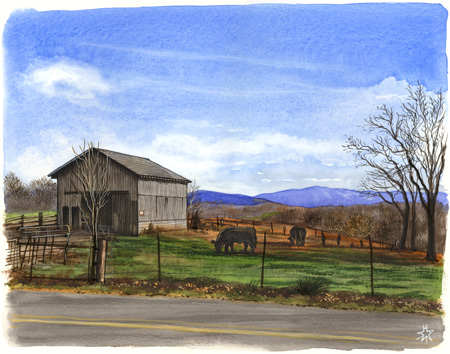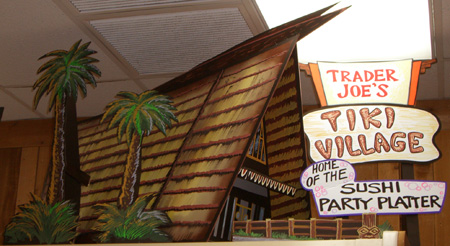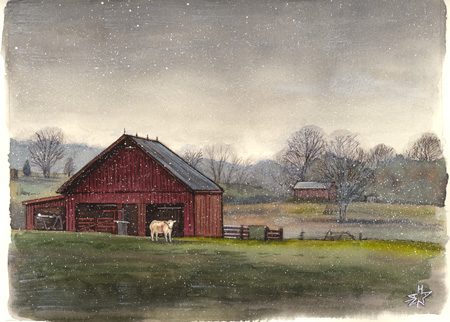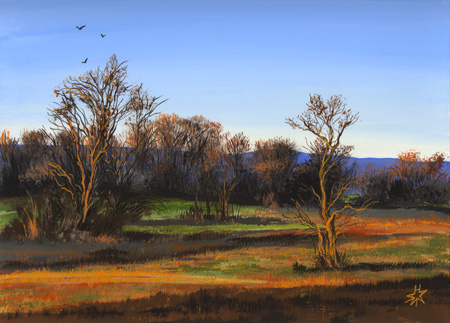My weblog ELECTRON BLUE, which concentrated on science and mathematics, ran from 2004-2008. It is no longer being updated. My current blog, which is more art-related, is here.
Fri, 29 Feb, 2008
A Bright Winter Day
February, the dreariest month of the year, sometimes has quite a few brilliant clear sunny days. You don't forget it's still winter, though, because it's still cold. The sun itself seems cold. This extra day which we are granted every four years is just more February. And yet the birds are doing their courting and mating, because they are sure that spring is on its way.
While I was touring in the Appalachians I had a number of these bright days, and the scene depicted below is a portrayal of one of them. If it weren't so cold, I could sit a while on the porch on that proverbial rocking chair and watch the clouds go by. This painting is for an upcoming exhibition in Staunton, VA.
"A Bright Winter Day." Watercolor on board, 11" x 14".

Posted at 4:10 am | link
Mon, 25 Feb, 2008
Tiki Village
I've been doing some interesting stuff at Trader Joe's. The current theme of our store is "Retro Tiki" (see here for some examples of this style, which was popular in the 1950s and 60s.). Once upon a time this pseudo-Polynesian style could be found in cities and towns all over America. Now it has almost disappeared, except for some remaining samples in California and other Western states. Trader Joe's began in the 1960s when this tiki style was still prevalent so there is a sort of "authenticity" about decorating a TJ's in the style. I grew up in Massachusetts, where there was very little of this style, except for the amazing Kowloon Restaurant in Saugus, a lowbrow entertainment place where no self-respecting intellectual would ever set foot.
I was tasked to create a three-dimensional architectural display for the top of a refrigerated box featuring foods you can just pick up and eat for lunch or quick dinner, such as sandwiches, sushi, salads, prepared meals and other goodies. The manager, who is from California, asked for a tiki house restaurant. I had to refer to books such as the excellent Tiki Modern as well as websites like the one I referenced above. I chose a famous tiki structure from the pages of the book and created a painted architectural model out of foamboard glued and taped together, complete with 60s typefaces and stage set palm trees. I have never actually built an architectural model before but I have lots of training in architectural drawing. I also drew on my observations of a miniature city built by a friend of mine who is a stage designer.
I finished "Trader Joe's Tiki Village" on Sunday evening so here it is for you to visit and enjoy. To actually enter the Tiki Hut, though, you must be about six inches tall.

Posted at 2:29 am | link
Sun, 24 Feb, 2008
Creativity
Creativity is for amateurs. That's what I heard, growing up among professional artists in a rarefied artistic world. You weren't an "artist," that was a pretentious way of referring to yourself. Never tell anyone you are an "artist." Instead, visual artists are "painters," which has always reminded me not of someone working in a studio but of the spattered pair of guys who show up with ladders, dropcloths and rollers to improve your interior design with a coat of "Practical Beige." Someone who writes poetry must never call himself a "poet," which was a word more suitable to romance novels than a struggling wordsmith.
Since you were not an artist, you were a craftsman. It was appropriate to talk about "the work," or "the craft," or every so often, "the piece" or "the passage." But not about "My Symphony" let alone "My Masterpiece." A "real" artist must constantly duck under these broad beams of popular definition, and think of him or herself as a kind of "cultural worker," to use a faded Marxist phrase. Another acceptable metaphor was a kind of "medical" view, where you did art for "hygienic" reasons, suggesting that you should have a healthy artistic movement every day.
In that mid-twentieth century time, which is when I got my admittedly inadequate amount of art training, this was how you were to view things. I learned my craft mainly from my own parents, and from brief periods at the Boston Museum School and Boston University art school. This northeastern art milieu valued technique over everything. For instance, I attempted to learn to play the piano in my childhood. Piano playing was about playing major and minor scales and arpeggios until you could play them fast and clearly with no mistakes. Then it was about playing Bach inventions or other technical pieces until you could play those clearly and with no mistakes. In the years that I tried to learn to play piano, I don't remember a single instance where the teacher said that you could just sit down at the piano and improvise something. Music is a fixed text, from which no deviation is possible, at least for a student. And I would always be a student.
With the visual arts, technique also ruled. The idea was to learn the media, most often pencil, charcoal, or oil paint, and then use them to create realistic pictures. That is what I spent my art school days doing. I don't mean "photo-realism," which was a trend around that time. But I wasn't doing abstraction, either, unless it was a technical exercise. Art consisted of drawing and drawing and drawing and painting and painting, especially your still life or unclothed models, in a realistic style. This was and still is the "classical" way to learn art. But as with piano-playing, I don't remember being invited by my Boston University professors to make something that was not "realistic."
A quick trip to the current Boston University art school website reveals a combination of the traditional "realistic" style I learned, with more modernist output. Much has changed in art schools since I went there. But the artists are still academics.
What about "creativity," then? The professors of technique insist that if you do enough work and get technically perfect, then something "creative" and meaningful will emerge on its own without your having to invoke any divine intervention. Just keep on drawing figures or urban street scenes or playing those scales and arpeggios, and you will find something to make art about. But what if that doesn't happen, and you spend your artistic life painting endless tasteful figures and landscapes? Boiling beneath the placid levels of fine technical academic art is a world of inferior but wildly "creative" artistic efforts, some of it done by people whose only training is copying album covers or comic books. They don't mind calling themselves "creative artists," because unlike "fine art" painters, they have no taste and no shame.
Posted at 3:47 am | link
Tue, 19 Feb, 2008
The Naming of Photoshop Brushes
I like to name things. I will name anything so that I can manage it better. I would rather call something by a name than by just some combination of letters and numbers. When it came to Photoshop, I had to name something or just stop using it out of confusion.
Photoshop when used for artistic purposes has many different color and text application tools, all of them used to manipulate the image on the screen. There is no paint or water involved, just pixels and electronic effects. The tools, however, are still called "brushes" by Photoshop and its users, as if they actually were applying real paint. But the real medium in Photoshop is a universal electronic manipulatable substance. It's as if all the delicious varieties of gourmet food you ate were really all simulated from tofu. Photoshop "brushes" attempt to put this electronic tofu into artificial paintings.
The program came with plenty of pre-set brushes, and I've downloaded or created many more. The pre-sets came with descriptive names that claimed to approximate a brushstroke or mark made by a "real" medium, such as oil paint, charcoal, watercolor, pencil, or airbrush. They didn't really "paint," though, since even an electronic tablet and stylus has little tactile resemblance to a real paintbrush. But if you looked at the marks the stylus conveyed to the screen, you might, with enough imagination, see a brushstroke or a pen line.
What was totally different was that, since you were really painting with universal electronic tofu, you could put any medium together with any other one, regardless of whether they could possibly go together in the "real" art world. In Photoshop, you can paint an "oil paint" background and then draw over it in "charcoal" or spray it with "airbrush." Colors that would never cover over anything in the "real" world, such as yellow or pale green, can slice right into your composition without any use of underpainting or building up layers of goo. Any texture, any level of opaqueness, is there for you to use.
As a traditional artist who has worked with traditional media all my life, I confess to feeling a kind of melancholy as I explored Photoshop's endless library of "brushes" and special effects. It is the kind of melancholy that you might feel if you received, like the legendary Chinese emperor, a jeweled mechanical nightingale which sang perfect songs, so much richer than the real one that you would be tempted to forget about the real bird. I can change from "colored pencil" to "airbrush" in a second, and then to "oil paint," even though in the studio this would take hours of arranging, if it were even possible at all.
But I want to continue using Photoshop. How could I solve this peculiar problem? I received inspiration from my facility with naming things. Since I know that digital art is really all one medium, not anything made of chemicals, pigments, and organic extracts, why would the "brushes" have to refer to anything from the old traditional ways? It was possible to extract from the artificial brush the essence of its effect, eliminating the dismaying description. Therefore "charcoal" became "Rough Texture," and "oil pastel" became "mushy irregular stroke." "Pastel" and "chalk" became "Granular Textures," and "spatter" became "Fractal Bits." I made Photoshop usable to me by de-naturing it. There are no brushes there, nor bits of charcoal or erasers or jars of murky water or paint slime on the palette. Ultimately it has no name at all. It is just ones and zeros. But do I still long for the real bird's song?
Posted at 3:03 am | link
Thu, 14 Feb, 2008
Still Winter
Not all my Appalachian days had bright blue skies. I went through a couple of gloomy weather days, including one snowy afternoon in the mountains of southwest Virginia. The colors of the winter landscape under snow and grey clouds are just as lovely as the bright sunlit scenes, but in a different, muted way. Here's a view of Appalachian Winter, complete with a beige cow.
Watercolor and pencils on paper, 8 1/2' x 11".

Posted at 3:45 am | link
Tue, 12 Feb, 2008
Memento Mori
If you do as much web surfing as I do, you cannot help but notice the ads, especially since they appear on major websites like Yahoo and the Weather Channel. They show female faces morphing from smooth youth to wrinkled age, then back to youth with the application of whatever product is advertised. Wrinkle cream, chemical injections, skin peels, and lip puffers are all in my face wherever they can put an ad. There is a parlor selling this sort of stuff right next to my workplace, and it's not the only one in the neighborhood.
I am a female of a Certain Age and there are millions of me in the United States. We are all attached to the media whether we like it or not. And the "beauty industry" knows just how to keep us hooked. Those morphing young-to-old faces are like our lives in the mirror compressed to a few seconds. They lance it home to us that our youth is gone. The rest of the media, with an insistence that feels like repeated injections, shows us endless armies of pimped-out girls in high heels whose original bodies have been surgeried and dyed and depilated and Photoshopped almost out of existence. The important thing is that people prefer the artificial to the real, whether they admit it or not.
Some writers have talked about the "pornification of culture" (this book was written in Finland and published in England, not in America, so it should be taken seriously) and the influence of pornography in American society in this 2005 book by Pamela Paul. I have noticed the increasing raunchiness myself over the past twenty or even thirty years, but I don't know whether it is my right to comment about it. Anything I say would come out sounding like a prudish old biddy. And the males I know are all in favor of it. It's a steady stream of scantily clad tit-illation and soft porn that they don't even have to pay for!
For me, the morphing female faces are the modern version of an ancient artistic motif: the skull on the table. It's called a memento mori, which is a compressed Latin phrase meaning basically "Remember, you will die." We, the aging female consumers in a culture that idolizes female beauty (and it's not just America…try Brazil) are forever past our brief teenaged moments of fresh, slim, graceful allure, if we ever had any to begin with. No amount of Botox or creams can hide the skull beneath the quickly shriveling skin.
Posted at 3:45 am | link
Sat, 09 Feb, 2008
Trigonometry Not Really for Dummies
I am reading TRIGONOMETRY FOR DUMMIES one or two pages at a time. I am quite impressed with the book so far. It isn't really aimed at "dummies," but at people who have a fairly good knowledge of high school algebra, which fortunately I haven't forgotten. Unlike many of the textbooks I have learned from, this one explains all the steps of solving a problem and also defines all the terms. It isn't perfect; I've been confused by a diagram for one thing sharing a page with a definition of another thing. But in general its explanations are clear and free of jargon.
One of the reasons this book is so helpful is that unlike the textbooks, this is designed for someone who is not in a classroom and does not have a teacher as a resource. It is for someone like me who wants to learn in a low-pressure and non-classroom situation. As you well know from reading my frustrated entries about trigonometry four years ago, I struggled with it because I had no one to ask about it, at least without trying to translate my question into an e-mail, and I found my textbooks confusing.
"Dummies" even presents me things that I never learned before, though they seem simple now. For instance, in the chapter about functions, it gives a technique for finding the inverse of a function. (Change f(x) for y, switch the x's in the function to y's and vice versa, then solve for y.) I was puzzled when I first encountered the idea of an inverse function, back in my algebra days, but I am puzzled no more.
The only thing I wish this book had was problem sets. Mathematics learning must always have problem sets. There is a "Trigonometry for Dummies Workbook" out there as a companion volume, which I will get soon. I am willing to work with it now, but when the books get into those maddening trigonometric identities, I may change my opinion. I already own the "Calculus for Dummies" book along with its workbook, but haven't done much with it lately. My current constraints allow only a little bit of math study at a time.
Posted at 4:19 am | link
Wed, 06 Feb, 2008
Shenandoah Twilight
Here's my next picture in my "Shenandoah" series. These are derived from images I captured in my photonic visual memory device during my trip through the Appalachians last month. This one's called "Shenandoah Winter Twilight." I am not making up the color of the mountains in the distance. The Blue Ridge Mountains are called that for a very good reason. I hope to show this piece at a gallery in Staunton, Virginia in the next months.
Acrylic on board, 9" x 11"

Posted at 3:26 am | link
Sat, 02 Feb, 2008
Heavy Equipment
I love construction and digging equipment. I also like tractors, harvesters, and fire and rescue vehicles. I'm like a little boy, that way. I love to see complex machines out on the street where I can examine them and sometimes watch them in action. They look great and are often painted in bright colors. If I am in the right place, and have my sketchbook with me, I can even draw a portrait of a piece of heavy equipment. I drew this crane from the warm, safe vantage point of a Starbucks coffeehouse.

I have often wished that there were "construction fun parks" for adults, devoted not to slides and rides but for people who wanted to work with heavy equipment such as backhoes and cranes. For a fee and some basic training, you would be able to put on a hard hat, sit in the cab, and guide the big mechanical arm or scoop to move loads of dirt in a grown-up-size sandbox. You could even have a mock "project" to complete, as if you were really building something. If this existed, I would sign up immediately.
This February 1 marks the fourth anniversary of ELECTRON BLUE. That's right, four years of persistence in blogging. And, as I was when I started the Electron, I am still working on trigonometry, this time in review, now that I know enough calculus to see the trigonometric functions in terms of limits and derivatives. Trigonometry is the heavy construction equipment of mathematics.
Posted at 3:57 am | link
